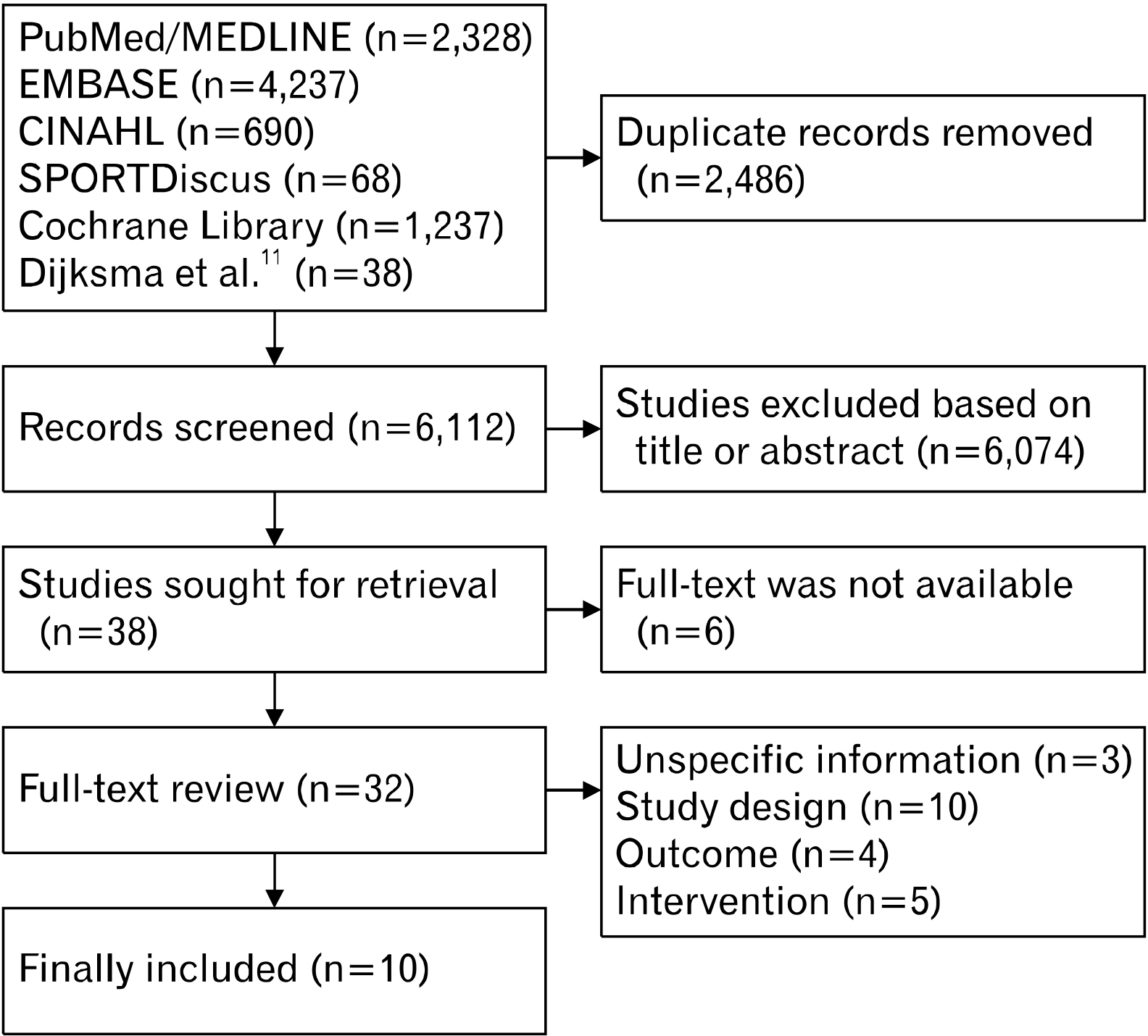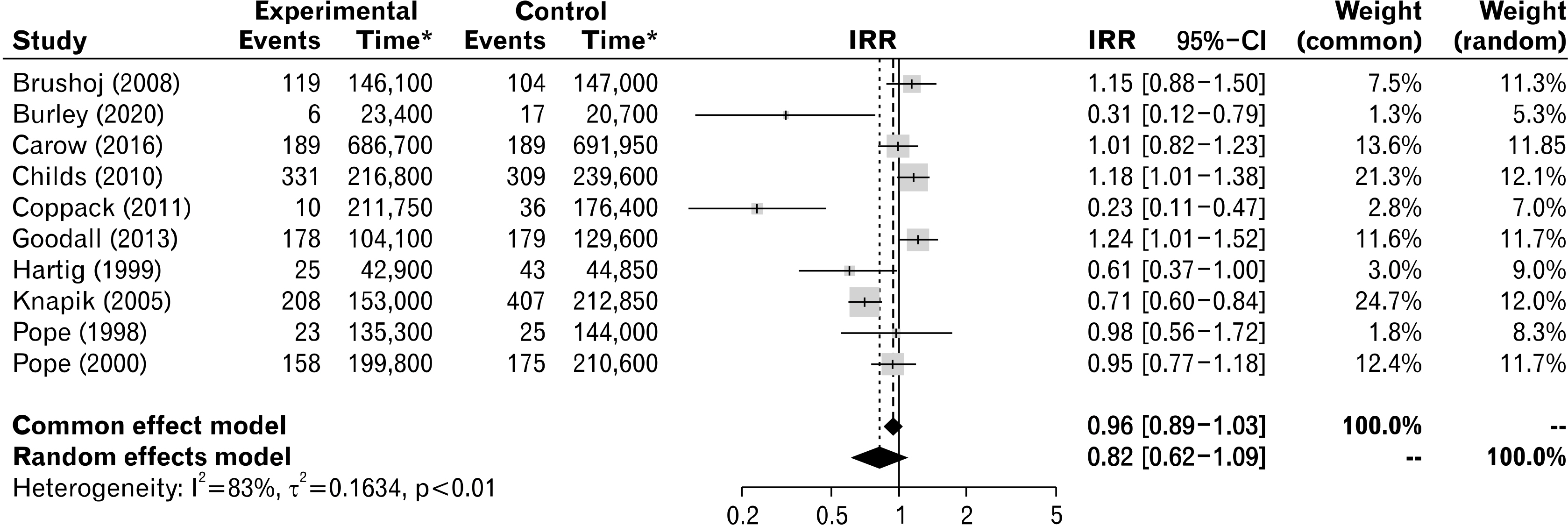Korean J Sports Med.
2024 Mar;42(1):1-11. 10.5763/kjsm.2024.42.1.1.
Systematic Review and Meta-analysis of Exercise for the Prevention of Musculoskeletal Injuries in Soldiers
- Affiliations
-
- 1Department of Physical Education, Korea Military Academy, Seoul, Korea
- 2Department of Aero Fitness, Korea Air Force Academy, Cheongju, 3 Korea Institute of Sport Science, Seoul, Korea
- 3Department of Physical Education, Seoul National University, Seoul, Korea
- 4Institute of Sport Science, Seoul National University, Seoul, Korea
- KMID: 2553551
- DOI: http://doi.org/10.5763/kjsm.2024.42.1.1
Abstract
- Purpose
This study aimed to conduct a systematic literature review and meta-analysis of the exercise intervention effects for the prevention of musculoskeletal injuries in military personnel.
Methods
Among studies that included military personnel as participants, we identified randomized controlled trials (RCTs) and cluster-RCT studies that used exercise interventions as a method for injury prevention. Exercise encompassed all types of physical activity, and the effect size was determined by the ratio of injuries between groups. Literature searches were conducted with search terms modified to ensure common inclusion of keywords such as “Soldier,” “Injury prevention,” and “Exercise.” For the analysis of potential factors, variables selected for group differentiation included gender, risk of bias, exercise volume, injury location, exercise type, and study design.
Results
Among a total of 8,598 search results, 10 papers were finally confirmed. The meta-analysis of all 10 papers showed that there was no statistically significant injury prevention effect, and significant heterogeneity was observed among the studies (incidence rate ratio, 0.82; 95% confidence interval, 0.62–1.09, I2 =83%). Subgroup analysis revealed a significant 44% reduction in injuries in studies where exercise volume for injury prevention was relatively high. However, no significant injury prevention effects were observed in other potential factors between groups.
Conclusion
The results of this study suggest that the effectiveness of injury prevention exercises in military settings was not statistically significant. However, through the analysis of potential factors, it was confirmed that increasing the time spent on injury prevention exercises may have a preventive effect on injuries.
Figure
Reference
-
1. Ministry of National Defense (Korea). 2020. 2020 Defense statistics yearbook 2020 [Internet]. Ministry of National Defense;Available from: https://www.mnd.go.kr/user/boardList.action?command=view&page=1&boardId=O_46843&boardSeq=I_10527100&titleId=&siteId=mnd&id=mnd_050600000000&column=null&search=null. cited 2023 Nov 22.2. Ministry of National Defense (Korea). 2014. 2014 Defense white paper [Internet]. Ministry of National Defense;Available from: https://www.mnd.go.kr/user/mnd/upload/pblictn/PBLICTNEBOOK_201501080301583540.pdf. cited 2023 Nov 22.3. Ministry of National Defense (Korea). 2020. 2020 Defense white paper [Internet]. Ministry of National Defense;Available from: https://www.mnd.go.kr/cop/pblictn/selectPublicationUser.do?siteId=mnd&componentId=14&categoryId=15&publicationSeq=897&pageIndex=1&id=mnd_040501000000. cited 2023 Nov 22.4. Kim J, Sung H, Lee S, Seo S. 2017; Current status and prevention of physical training related musculoskeletal injuries among Korea Military Academy cadets. Korean J Mil Sci. 73:279–302. DOI: 10.31066/kjmas.2017.73.1.011.
Article5. Chang EW, Jung EJ, Kim Y. 2018; Orthopedic injury epidemiology in Korea Navy population. Exerc Sci. 27:184–90. DOI: 10.15857/ksep.2018.27.3.184.
Article6. An SJ, Lee SH, Moon GH. 2021; Epidemiology and incidence of orthopedic fractures in the military of the Republic of Korea. J Trauma Inj. 34:50–6. DOI: 10.20408/jti.2020.0046.
Article7. O'Donnell FL. 2021; Surveillance snapshot: illness and injury burdens, reserve component, U.S. Armed Forces, 2020. MSMR. 28:26.8. Zambraski EJ, Yancosek KE. 2012; Prevention and rehabilitation of musculoskeletal injuries during military operations and training. J Strength Cond Res. 26 Suppl 2:S101–6. DOI: 10.1519/JSC.0b013e31822e7721.
Article9. Bullock SH, Jones BH, Gilchrist J, Marshall SW. 2010; Prevention of physical training-related injuries recommendations for the military and other active populations based on expedited systematic reviews. Am J Prev Med. 38(1 Suppl):S156–81. DOI: 10.1016/j.amepre.2009.10.023. PMID: 20117590.10. Wardle SL, Greeves JP. 2017; Mitigating the risk of musculoskeletal injury: a systematic review of the most effective injury prevention strategies for military personnel. J Sci Med Sport. 20 Suppl 4:S3–10. DOI: 10.1016/j.jsams.2017.09.014. PMID: 29103913.
Article11. Dijksma I, Arslan IG, van Etten-Jamaludin FS, Elbers RG, Lucas C, Stuiver MM. 2020; Exercise programs to reduce the risk of musculoskeletal injuries in military personnel: a systematic review and meta-analysis. PM R. 12:1028–37. DOI: 10.1002/pmrj.12360. PMID: 32162467. PMCID: PMC7586796.
Article12. Moher D, Liberati A, Tetzlaff J, Altman DG. PRISMA Group. 2009; Preferred reporting items for systematic reviews and meta-analyses: the PRISMA statement. PLoS Med. 6:e1000097. DOI: 10.1371/journal.pmed.1000097. PMID: 19621072. PMCID: PMC2707599.
Article13. Higgins JP, Thomas J, Chandler J, editors. Cochrane handbook for systematic reviews of interventions. 2nd ed. John Wiley & Sons;2019. DOI: 10.1002/9781119536604.14. Furlan AD, Pennick V, Bombardier C, van Tulder M. Editorial Board, Cochrane Back Review Group. 2009; 2009 Updated method guidelines for systematic reviews in the Cochrane Back Review Group. Spine (Phila Pa 1976). 34:1929–41. DOI: 10.1097/BRS.0b013e3181b1c99f. PMID: 19680101.
Article15. Egger M, Davey Smith G, Schneider M, Minder C. 1997; Bias in meta-analysis detected by a simple, graphical test. BMJ. 315:629–34. DOI: 10.1136/bmj.315.7109.629. PMID: 9310563. PMCID: PMC2127453.
Article16. Duval S, Tweedie R. 2000; Trim and fill: a simple funnel-plot-based method of testing and adjusting for publication bias in meta-analysis. Biometrics. 56:455–63. DOI: 10.1111/j.0006-341X.2000.00455.x. PMID: 10877304.
Article17. Brushøj C, Larsen K, Albrecht-Beste E, Nielsen MB, Løye F, Hölmich P. 2008; Prevention of overuse injuries by a concurrent exercise program in subjects exposed to an increase in training load: a randomized controlled trial of 1020 army recruits. Am J Sports Med. 36:663–70. DOI: 10.1177/0363546508315469. PMID: 18337359.
Article18. Burley SD, Drain JR, Sampson JA, Nindl BC, Groeller H. 2020; Effect of a novel low volume, high intensity concurrent training regimen on recruit fitness and resilience. J Sci Med Sport. 23:979–84. DOI: 10.1016/j.jsams.2020.03.005. PMID: 32345543.
Article19. Carow SD, Haniuk EM, Cameron KL, et al. 2016; Risk of lower extremity injury in a military cadet population after a supervised injury-prevention program. J Athl Train. 51:905–18. DOI: 10.4085/1062-6050-49.5.22. PMID: 25117875. PMCID: PMC5224732.
Article20. Childs JD, Teyhen DS, Casey PR, et al. 2010; Effects of traditional sit-up training versus core stabilization exercises on short-term musculoskeletal injuries in US Army soldiers: a cluster randomized trial. Phys Ther. 90:1404–12. DOI: 10.2522/ptj.20090389. PMID: 20651013.
Article21. Coppack RJ, Etherington J, Wills AK. 2011; The effects of exercise for the prevention of overuse anterior knee pain: a randomized controlled trial. Am J Sports Med. 39:940–8. DOI: 10.1177/0363546510393269. PMID: 21212307.
Article22. Goodall RL, Pope RP, Coyle JA, Neumayer R. 2013; Balance and agility training does not always decrease lower limb injury risks: a cluster-randomised controlled trial. Int J Inj Contr Saf Promot. 20:271–81. DOI: 10.1080/17457300.2012.717085. PMID: 22924758.
Article23. Hartig DE, Henderson JM. 1999; Increasing hamstring flexibility decreases lower extremity overuse injuries in military basic trainees. Am J Sports Med. 27:173–6. DOI: 10.1177/03635465990270021001. PMID: 10102097.
Article24. Knapik J, Darakjy S, Scott SJ, et al. 2005; Evaluation of a standardized physical training program for basic combat training. J Strength Cond Res. 19:246–53. DOI: 10.1519/00124278-200505000-00002. PMID: 15903357.
Article25. Pope R, Herbert R, Kirwan J. 1998; Effects of ankle dorsiflexion range and pre-exercise calf muscle stretching on injury risk in Army recruits. Aust J Physiother. 44:165–72. DOI: 10.1016/S0004-9514(14)60376-7. PMID: 11676730.
Article26. Pope RP, Herbert RD, Kirwan JD, Graham BJ. 2000; A randomized trial of preexercise stretching for prevention of lower-limb injury. Med Sci Sports Exerc. 32:271–7. DOI: 10.1097/00005768-200002000-00004. PMID: 10694106.
Article27. Sports Medicine Australia, Aussie Sport (Program), Australian Coaching Council. Safety guidelines for children in sport and recreation. Sports Medicine Australia;1997.28. Hubley-Kozey C, Stanish W. 1990; Can stretching prevent athletic injuries. J Musculoskelet Med. 7:21–31.29. Bullock SH, Jones BH. Recommendations for prevention of physical training (PT)-related injuries: results of a systematic evidence-based review by the Joint Services Physical Training Injury Prevention Work Group (JSPTIPWG). U.S. Army Center for Health Promotion and Preventive Medicine;2003.30. Hrysomallis C. 2007; Relationship between balance ability, training and sports injury risk. Sports Med. 37:547–56. DOI: 10.2165/00007256-200737060-00007. PMID: 17503879.
Article31. Batterham AM, Hopkins WG. 2006; Making meaningful inferences about magnitudes. Int J Sports Physiol Perform. 1:50–7. DOI: 10.1123/ijspp.1.1.50.
Article32. Soomro N, Sanders R, Hackett D, et al. 2016; The efficacy of injury prevention programs in adolescent team sports: a meta-analysis. Am J Sports Med. 44:2415–24. DOI: 10.1177/0363546515618372. PMID: 26673035.
Article
- Full Text Links
- Actions
-
Cited
- CITED
-
- Close
- Share
- Similar articles
-
- An Introduction of the Systematic Review and Meta-Analysis
- Exercise and adults with hemophilia: a systematic review and meta-analysis
- Effect of Auriculotherapy on Musculoskeletal Pain: A Systematic Review and Meta-Analysis
- Effect of Exercise Intervention on Chronic Musculoskeletal Pain in Older Adults: Meta-analysis
- Systematic Review and Meta-analysis in Digestive Cancer Research




